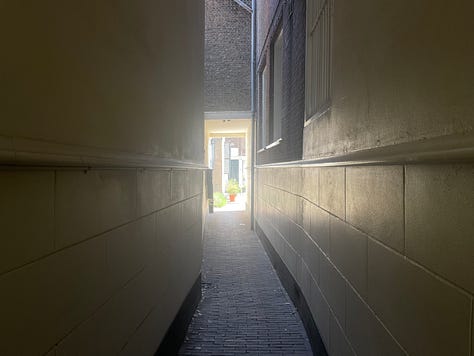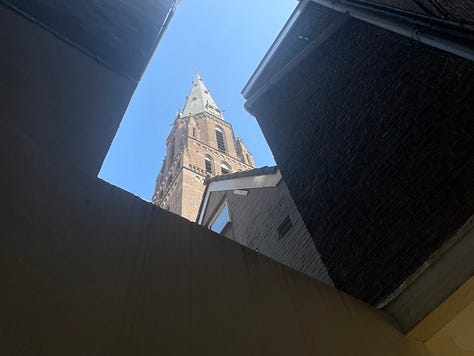Hi! I’m Patricia Hurducaș, a Romanian writer and urban explorer currently living in The Hague. I write about places, imagination, life abroad, and through this newsletter, The Flâneurs Project, I try to map through essays and interviews the evolving relationships we form with the places we inhabit, leave behind, or long for.
“In the city, time moves differently; it collapses, expands, and sometimes stands still.”
—Vivian Gornick, The Odd Woman and the City
“I have always loved the desert. One sits down on a desert sand dune, sees nothing, hears nothing. Yet through the silence something throbs, and gleams...”
— Antoine de Saint-Exupéry, The Little Prince
The Hofje
There’s a kind of silence in the churches of small towns and villages that has always made me think: this is what time sounds like. If you’re lucky enough to be completely alone, undisturbed by footsteps, whispers, or the click of a camera, eventually the silence itself envelops you, like an echo.
Recently, I’ve been wondering what the quietest urban place within minutes of my home could be. And so I came across the hofje.
A hofje is a very old Dutch concept - think of it as a small, hidden courtyard surrounded by modest houses, traditionally built to provide housing for elderly women, often widows, who could live independently but within a community. They were usually funded by wealthy benefactors as acts of charity and were often religiously inspired (Catholic or Protestant), though some were secular. They are, in a way, similar to English almshouses, but their architecture (enclosed garden), legal, and social conventions are quintessentially Dutch.
The oldest hofje in the country is the Hofje van Bakenes, in Haarlem, founded in 1395, built to house elderly women of limited means, similar to later hofjes. It is still in use today. On the beautifully ornate gate, one can read:
“Ingang vant Gesticht/ van Dirck van Baekenes/ voor Vrouwen acht en/ twee mael ses”
“Entrance of the foundation of Dirck van Baekenes for ladies eight and two times six”
The inscription cleverly encodes two meanings: (8 + 2) × 6 = 60, the minimum age for residents, and 8 + (2 × 6) = 20, the number of women the hofje could house.
My main reason for visiting these enclosed urban gardens is to discover what kind of quiet they hold. Living in a city with few pockets of quiet, apart from some distant beaches near the North Sea and the Haagse Bos, the “Central Park” of The Hague, I rarely experience urban time without unwanted jolts of stimuli at every pace.
I wonder what price we ultimately pay for the constant stimulation, offline and online. If I had to guess, I’d say it’s the clarity of our imagination.
The Feed
What could be the quietest place on the Internet? It’s not the feed. Even here, on Substack, the Notes wall is becoming noisier and noisier with the passing of time. After reading some old Reddit posts, in my attempt to answer this question, I came across The Thoughts Room, which was apparently a source of joy for many people in the past, but the project shut down some years ago. Someone decided to recreate it.
In the “I’m thinking” bar, people can type their thoughts, which then quickly drift away and disappear into the background of stars. Amusingly, the open comment section is overflowing with the most personal thoughts.
I’ve found some of the quietest places online in the corners of odd blogs, peculiarly curated boards on Pinterest, and Substack essays quieting my mind with honest writing and curiosities so filling that I stop scrolling the feed for more.
The Hofje
A few days after writing these paragraphs, I visited for the first time a hofje, tucked away behind a dark forest green door, very close to home. As I approached the address, I became more and more alert and uncomfortable: the street was close to the main road, and the traffic was as loud as ever. I couldn’t believe that an enclosed garden could be spared from the noise, not in this central area of The Hague.
I passed by the door and immediately missed it, it was hidden in plain sight.



The corridor was narrow, and the ceiling surprisingly high, the boundary between public and private life mapped very thinly.
As I closed the door, all the noise was abruptly and satisfyingly muted, and as I entered the garden, it felt like the outside world was no longer there. Two older women were planting flowers and talking. I walked and sat on a bench, and shortly after, the women went inside their home, leaving me alone in the garden. The only sound from the outside was, from time to time, the distant rumble of the tram making its way through the streets, and an airplane passing well above the clouds.
I sat and listened, and for a brief moment, the only sound I heard was the wind gently stirring the leaves overhead. Then I realized I was mistaken: this is what time sounds like.
Thank you for reading. As always, I welcome your notes and stories.
I’m planning an evening walk & talk in London on 25 June. If you’re interested in joining, please drop me an email.
Patricia








I can relate to this so much. I wander the city endlessly, and I've only recently realised how much I seek out quiet places. There's something magical about finding peace within a big city. You capture this feeling so well in this piece.
What a wonderful, beautiful read.